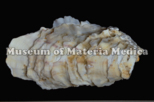Oyster Shell

|
TMPW No.:9086 |
| Synonym | |
| Latin name | Ostreae Testa |
| Botanical source: Family name | Ostreidae |
| Botanical source: Plant name | Magallana gigas (Thunberg) (GBIF:7820753) =Ostrea gigas Thunberg |
| Part used | Shell |
| Empirical criteria for quality selection | The fresher, the better. Gray ones are called "nezumide" and white ones are "yoshimasude" in Japan. (TN) |
| Constituents | Other: CaCO3, Ca3(PO4)2, Mg, Al塩, Fe2O3 |
| Pharmacological effects | Shelled oyster: decreasing in blood sugar (shelled oyster extract); strongthening immunity (neutral polysaccharide). Oyster shell: antacid, others are unknown. |
| Indications | As an antacid, thirst quencher, antisudorific and analgesic, it is applied to treat palpitation, mental trouble, insomnia and night sweat. Relieving hyperacidity drug. |
| Diseases | Scary constitution, Fret, Insomnia, Dream-disturbed sleep, Palpitation, Cramp, Lightheadedness, Headache, Ear buzzing, Numbness, Spontaneous sweating, Night sweats, Spermatorrhea, Irregular vaginal bleeding, Hypermenorrhea, Leukorrhea, Cervical lymphadenopathy, Stomachache |
| Formulas | anchusan , anchusankabukuryo , keishikaryukotsuboreito , keishikanzoryukotsuboreito , keishikyoshakuyakukashokushitsuryukotsuboreito , saikokaryukotsuboreito , saikokeishikankyoto , shikonboreito , teikiin |
| Meridian tropism | Liver, Gall bladder, Kidney |
| Property | Slightly cold |
| Flavor | Salty, Astringent |
| Classification in "Shen-non Ben-cao Jing" | Superior |
| TCM: Classification | Sedatives and tranquilizers |
| TCM: Medicinal effects | To tranquilize the mind by r eavy settling, subdue yang and repenish yin, soften hardness and dissipate binds. For fright palpitations and insomnia, dizziness and tinnitus, scrofula and phlegm nodule, aggregation accumulation masses, glomus. |
| Remarks | Listed in the Japanese Pharmacopoeia 18th ed. |
| References | TN: T. Namba & Y. Tsuda ed., Outline of Pharmacognosy, a Textbook, 3rd ed., Nankodo Co., Ltd., Tokyo, 1998. |
